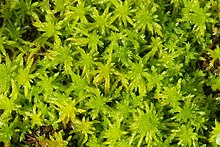Breitsee
| Breitsee | ||
|---|---|---|

|
||
| Breitsee | ||
| Geographical location | Kanton Aargau | |
| Data | ||
| Coordinates | 632 483 / 269 621 | |
|
|
||
| surface | 6 ha | |
The Breitsee is a small flat moor in the municipality of Möhlin , Canton Aargau , Switzerland . The approximately 6 ha large nature reserve is an amphibian spawning area of national importance.
location
The Breitsee is located northeast of the municipality of Möhlin in the Oberforst area , around 1.2 km south of the Rappertshäuser desert on the Rhine . The moor lies in a hollow at around 330 m above sea level. M. and is surrounded by forest. The nature reserve can only be reached via small forest paths and paths.
Emergence
During the Riss glaciation around 140,000 years ago, the Möhliner Feld formed the most north-westerly point of the Alpine glaciation. At that time, a mighty glacier tongue or terminal moraine extended over the area .
With global warming and the end of the Ice Age , the glaciers began to melt and gradually retreated. At the edge of the terminal moraine a hollow was created, in which weathering dust could be deposited over the course of thousands of years . This led to the formation of a meter-thick, waterproof layer.
In the period from around 3000–1000 BC The bog began to form. Since dead plants only degrade to a limited extent in wet soil, they are deposited in the form of peat .
The Breitsee was originally a swampy peat bog. The oldest peat fossils in the canton of Aargau were found here. The swampy area had neither a natural inflow nor outflow, but was in contact with the groundwater .
With the drainage and the planting of birch and red fir trees , the destruction began in 1827. At that time the peat layer was 80 cm thick. It is thanks to the increasing environmental awareness of the people that the lake was saved from complete siltation just in time . The leaky drain was sealed again in 1968 with clay . Although the lake had suffered from drainage for decades, thanks to this measure, the habitat of numerous animal and plant species could be preserved.
Even today, the Breitsee has no natural inflow and is fed exclusively by surface and groundwater. Due to the large number of peat particles that float in the lake water, the Breitsee appears cloudy from close up and almost black from the air.
Flora and fauna
The Breitsee nature reserve offers the habitat of around 140 plant species.
The inhabitants of the flat moor have to find their way under barren conditions. The soil is soaked with water almost continuously up to the surface. In the area of the roots there is a great lack of oxygen; the nutrients are limited. Only specialized plant species can thrive under these conditions. At Breitsee there are mainly various sour grass plants , most of which belong to the sedge genus .
The last surviving stocks of the rare quarry forest with birch and black alder rich in peat moss are particularly valuable .
Species of orchids , primroses and irises also grow on Breitsee . Many of them are rare and protected.
The flat moor also offers the habitat of numerous animal species. Some insect species need very specific plants to lay their eggs, which they can only find in reeds (moorland). Amphibian and dragonfly species are numerous in the Breitsee nature reserve . Various types of beetles and grasshoppers can only be found on the constantly moist reed soil, and many nectar-seeking insects are dependent on the summer flowers.
The inhabitants of the nature reserve also include many birds that appreciate the Breitsee as a breeding site. Little grebe , moorhen and tufted duck , but also tree falcon and black woodpecker and other songbirds can be observed frequently . In spring and autumn the lake is also visited by migratory birds , which it serves as a resting place.
Other nature reserves nearby
- Ägelsee ( Toteissee , 1.5 km southeast)
- Haumättli ( floodplain area on the Rhine, 1.3 km northeast)
Individual evidence
- ↑ Ordinance on the protection of amphibian spawning areas of national importance: ( PDF ), p. 17
- ↑ Article by the municipality of Möhlin about the Breitsee ( Memento of the original from April 22, 2009 in the Internet Archive ) Info: The archive link was inserted automatically and has not yet been checked. Please check the original and archive link according to the instructions and then remove this notice. , see section 1




